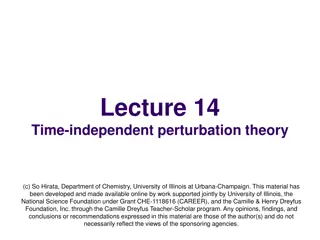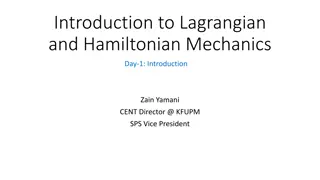Operator Formalism in Quantum Mechanics
Dive into the world of quantum mechanics with Dr. N. Shanmugam as he explains the role of operators, their significance in quantum mechanics, and how they are used to determine physical quantities through expectation values. Explore concepts such as the Hamiltonian operator, time-independent Schrodi
2 views • 49 slides
Introduction to Quantum Mechanics: Energy Levels and Schrödinger Equation
Quantum mechanics reveals that all systems possess discrete energy levels, determined by solving the Schrödinger equation where the Hamiltonian operator represents total energy. In a particle-in-a-box scenario, potential energy is infinite outside the box. The Schrödinger equation simplifies to a
0 views • 12 slides
Electronic Excitation in Semiconductor Nanoparticles from a Real-Space Quasiparticle Perspective
This research delves into the electronic excitation in semiconductor nanoparticles, focusing on real-space quasiparticle perspectives. It explores treating electron correlation using explicit operators, leading to faster algorithms while calculating optical gap and exciton binding energies. Various
0 views • 45 slides
Quantum Circuit Simulations and Electromagnetic Analyses in Quantum Photonics
Explore the world of quantum photonics with insights into two-qubit photon counters, jointed cavities, qubit pads, and quantum circuit simulations. Ansys simulations and experimental data by researchers Alessandro D'Elia and Claudio Gatti provide in-depth analysis of quantum phenomena. Discover the
0 views • 7 slides
Time-Independent Perturbation Theory in Quantum Mechanics
Perturbation theory is a powerful tool in solving complex physical and mathematical problems approximately by adjusting solutions from a related problem with known solutions. This theory allows for more accurate approximate solutions by treating the difference as a small perturbation. An example inv
0 views • 19 slides
Classical Mechanics and Fields in Physics
Explore the concepts of radiation, matter, fields, Hamiltonian, and more in classical mechanics with a focus on velocity-dependent potentials and conservative systems. Dive into the detailed discussions on gauge theory, Coulomb gauge, magnetic fields, and Hamiltonian operators within the framework o
0 views • 28 slides
Density Functional Theory in Computational Chemistry
Dive into the formalism and applications of Density Functional Theory (DFT) through a comprehensive review of basic theory, equations, and numerical implementations. Explore concepts like Time-Dependent DFT (TDDFT) and Linear Response formalism, and discover its applications in studying plasmons, co
0 views • 26 slides
Overview of Damping Rings in Linear Colliders
This content provides insights into the basics of damping rings in linear colliders, covering topics such as ring equations of motion, betatron motion, emittance, transverse coupling, dispersion, and momentum compaction factor. It delves into the equations of motion governing particle behavior in el
3 views • 34 slides
Nuclear Shapes at Critical Point of U(5)-SU(3) Phase Transition
Exploring nuclear shapes at the critical point of the U(5)-SU(3) nuclear shape phase transition using Bohr Hamiltonian with a sextic oscillator potential. The study investigates the transition from a spherical vibrator (U(5)) to a prolate rotor (SU(3)), providing insights into the Interacting Boson
0 views • 10 slides
Fixed Point Collisions in Luttinger Semimetals and Field Theories
Exploring fixed point collisions and tensorial order parameters in Luttinger semimetals and various field theories, such as chiral symmetry breaking in QED and Interacting O(N) field theory. The research delves into the condensed matter motivation behind quadratic band touching and the Luttinger Ham
0 views • 39 slides
Finding Reductions in NP-Hardness Proofs
To find a polynomial-time many-one reduction from a known NP-hard decision problem A to a target problem B, ensure that the reduction maps inputs correctly such that the output for A is 'yes' if and only if the output for B is 'yes.' An example is demonstrated using Subgraph Isomorphism and Hamilton
0 views • 32 slides
Coulomb Interaction in Many-Particle Hamiltonian
Explore the treatment of Coulomb interaction in a many-particle Hamiltonian, where careful integration is crucial due to divergence issues. Learn about solving the Coulomb Hamiltonian with Slater integrals and expanding the operator on spherical harmonics for analytical solutions. Discover the signi
0 views • 15 slides
Coulomb Repulsion and Slater Integrals
Dive into the intricate world of Coulomb repulsion and Slater integrals, essential concepts in quantum physics. Explore the challenges posed by the diverging Coulomb integral and the complex calculations required to evaluate these interactions. Discover how Slater integrals play a crucial role in cr
0 views • 14 slides
Uniquely Bipancyclic Graphs by Zach Walsh
Research conducted at the University of West Georgia focused on uniquely bipancyclic graphs, defined as bipartite graphs with exactly one cycle of specific lengths determined by the order. Uniquely bipancyclic graphs have special properties, including having a Hamiltonian cycle and a specific order
0 views • 18 slides
Closest Points and Convex Hull in Divide and Conquer Algorithms
Exploring the divide-and-conquer approach to solving problems like finding the minimum distance between points on an xy-plane, and understanding concepts such as Gray Code and Hamiltonian Cycles in algorithm design. Dive into lexicographic permutations, efficient calculations, and examples seen in c
1 views • 16 slides
Extensions of Hamiltonian Formalism in Classical Mechanics and Mathematical Methods
Lecture 9 on the extensions of Hamiltonian formalism covers topics such as the Virial theorem, canonical transformations, and the Hamilton-Jacobi formalism. It delves into proofs and examples related to the Virial theorem, including applications to the harmonic oscillator and circular orbits in grav
1 views • 26 slides
Chirping Mode Dynamics in Tokamak Equilibria
Chirping Alfvén modes in Tokamak equilibria exhibit frequency variation, allowing for maximizing power extraction from fast particles. Investigation of a chirping mode with Hamiltonian-Mapping and analysis of relevant phase-space slices reveal insights into the dynamics, resonance, and density grad
0 views • 41 slides
P, NP, NP-Hard, NP-Complete Problems and Amortized Analysis
This comprehensive study covers P, NP, NP-Hard, NP-Complete Problems, and Amortized Analysis, including examples and concepts like Reduction, Vertex Cover, Max-Clique, 3-SAT, and Hamiltonian Cycle. It delves into Polynomial versus Non-Polynomial problems, outlining the difficulties and unsolvability
0 views • 32 slides
Optimizing Continuous Quantum Control with Variable Parameters
The research delves into solving quantum optimal control problems with versatile system parameters through robust and analytical approaches. It explores optimizing figures of merit in quantum systems with varying Hamiltonian and pulse parameters, showcasing solutions for single-qubit and two-qubit s
0 views • 18 slides
Introduction to Lagrangian and Hamiltonian Mechanics: A Comprehensive Overview
This course provides a detailed introduction to Lagrangian and Hamiltonian Mechanics, covering topics such as the nature of physics, differentiation, calculus of variation, coordinate systems, and getting ready for Lagrangian Mechanics. It explores the relationship between math and physics, utilizin
0 views • 15 slides
USPAS Classical Mechanics & Electromagnetism Course Overview
This USPAS course covers Classical Mechanics and Electromagnetism with a focus on topics such as Hamiltonian mechanics, accelerator magnets, relativity, and more. Taught by a team of expert instructors, the course structure includes lectures, homework sessions, exams, and graded assignments. Resourc
0 views • 7 slides
Graph Theory: From Knigsberg Bridge Problem to Traveling Salesman Problem
Delve into the realm of graph theory with a historical perspective on the Knigsberg Bridge Problem and advancements like the Traveling Salesman Problem. Uncover the foundations of non-directed graphs, Hamiltonian graphs, and their real-world applications.
0 views • 21 slides
Bayesian Statistics with Stan and brms: A Feasible Approach to Inference
Bayesian inference and how it can be applied feasibly in research using Stan and brms. Explore the concept of giving prior distributions to model parameters and obtaining posterior distributions. Learn about Markov Chain Monte Carlo (MCMC) simulation and Hamiltonian Monte Carlo (HMC) for faster conv
0 views • 19 slides
Molecular Dynamics in NVE Ensemble: Equations and Conservation Laws
In this resource, learn about molecular dynamics in the microcanonical ensemble using the Verlet algorithm, equations of motion for atomic systems, Hamiltonian/Lagrange equations, conservation laws, and time reversibility. The content details solving ordinary differential equations and the standard
0 views • 28 slides
Approximation Employed in Spontaneous Emission Theory / D.F. Walls and C.W. Gardiner (Physics Letters 41A (1972))
Examining the approximations utilized in Spontaneous Emission Theory by Walls and Gardiner in 1972. Discusses the motivation, Hamiltonian derivation, and comparisons between R.W.A and the Ladder approximations.
0 views • 24 slides
Basics of DFT and TDDFT
Delve into the fundamentals of Density Functional Theory (DFT) and Time-Dependent Density Functional Theory (TDDFT) through the works of Hardy Gross, a prominent researcher at Max-Planck Institute of Microstructure Physics. Explore the Hamiltonian of condensed matter systems, including atoms, molecu
0 views • 36 slides
Gaussian Processes to Speed up Hamiltonian Monte Carlo
Bayesian inference, Metropolis-Hastings, Hamiltonian Monte Carlo, and Markov Chain Monte Carlo are explored in the context of sampling techniques and estimation of probability distributions in complex models. The use of Gaussian processes to enhance the efficiency of Hamiltonian Monte Carlo is discu
0 views • 14 slides

























